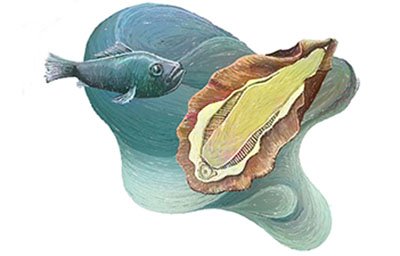Nature’s Midas Touch
Biominerals
In Greek mythology, King Midas was granted a wish in return for a kind deed. The wish? To turn everything he touched into gold.
Anyone familiar with this story knows that the king’s greedy wish ended in disaster (unlimited riches seem great until you try biting into a gold-plated turkey leg). But what if there were organisms that could turn organic material into gold (and other metals) without the inconvenient side effects? Because of God’s creative genius, there are!
Select organisms can combine organic molecules (such as tissues or proteins) with minerals to create biominerals. These composite structures provide the organisms with enhanced strength and protection. Though these organisms may not be amassing monetary wealth, their ability to produce biominerals certainly enrichens their lives.
Not-So-Basic Biominerals
When you visit the beach and gather seashells, you hold in your hands some of the most common examples of biomineralization. Creatures such as snails and clams mix the mineral calcium carbonate with organic matter to produce the beautifully unique shells that we love to collect. These shells may seem like basic souvenirs to us, but they’re actually part of an elaborate process God established to provide for the survival and safety of some of his more vulnerable creatures.
Just as God created these organisms with exactly what they need to survive, thrive, and endure potentially lethal situations in a world corrupted by sin, God has equipped us through his Spirit with everything we need to endure seemingly impossible circumstances.
Job 23:10 says, “But he knows the way that I take; when he has tried me, I shall come out as gold.” Though we may face overwhelming grief, crushing defeat, and imposing obstacles in life, our God will strengthen and purify us through these trials as only he can.
Tough Teeth

The gumboot chiton (Cryptochiton stelleri) is a marine mollusk that lives along the rocky coastline of the northern Pacific Ocean. At full size, the chiton reaches 13 inches (33 cm) long, making it the largest of its class.
Although this mollusk looks like a lumpy meatloaf on the outside, scientists find what lies inside its shapeless exterior quite intriguing. Its mouth contains a radula, a bizarre tongue-like structure resembling a zipper with several dozen rows of teeth. It uses these teeth to scrape red algae off rocks for breakfast, lunch, and dinner. Normal teeth would quickly wear away, but the chiton’s teeth are coated in magnetite (a magnetic iron oxide), making them as hard as steel. Additionally, the connective tissue holding its teeth to its radula contains santabarbaraite, a rare magnetic compound that further toughens each tooth. When it comes to biomineralized marvels, the gumboot chiton’s teeth are among the strongest and most durable of any living creature.
Nature’s Blue Blood

Biological creatures aren’t the only organisms that can produce biominerals. Some plants and trees flourish in environments containing high mineral concentrations. Rather than being poisoned by the toxic metals, these organisms produce marvelously metallic latex that may potentially ward off predators and parasites.
Known as hyperaccumulators, these plants absorb toxic metals such as nickel, zinc, or even arsenic at levels hundreds of times greater than other plants can tolerate.
In the rainforests of New Caledonia (a string of islands in the South Pacific) lives the 60-foot Pycnandra acuminata—one of the earth’s most metallic trees. Chemical analysis of the tree’s latex (the gooey substance that oozes from some vegetation) shows that it contains up to 25% nickel. This high concentration of metal turns the tree’s latex a neon blue-green color.
Microscopic Moneybags
Surviving in toxic soils containing arsenic, cadmium, and other heavy metals is an incredible feat for any microorganism. But the single-celled bacterium Cupriavidus metallidurans is the gold standard for thriving in contaminated conditions.
Though C. metallidurans uses trace amounts of copper for its cellular growth, too much of this heavy metal could prove fatal. To protect itself, the bacterium employs an enzyme called CopA to transform unstable copper and gold ions into stable metals that can’t penetrate the cell’s inner structure, thereby neutralizing potential threats. The by-products of this process are microscopic gold nuggets which are stored in the cell’s periplasmic space until they eventually spill out of the cell’s membrane.
Mineral vs. Metal
Minerals (such as gypsum, quartz, and magnetite) are compounds with crystalline structures. They are usually brittle and dull in appearance. In contrast, metals (such as gold, silver, copper, and nickel) are pure mineral elements that are malleable and glossy.
Despite these gold nuggets being only a few nanometers big, they are a massive testimony to the provision of God. Even the tiniest organisms are equipped with what they need to neutralize threats.
Lookin’ Sharp

Serrated knives are great for cutting through steak or bread, but this invention is not unique to mankind. A species of female fig wasp (Apocrypta westwoodi grandi) uses a serrated, metal-tipped ovipositor (a tubular organ used to lay eggs) to penetrate figs.
Though the wasp’s ovipositor is only 15 microns wide (about 1/5 the diameter of a human hair), it is reinforced with zinc, keeping it remarkably sharp despite repeated use. Using this natural “drill bit,” the wasp easily punctures the hard exterior of figs to inject its eggs. Parasitic fig wasps choose fruit that contains a ready supply of other insects’ larvae. When their own larvae hatch, they can feast on the other underdeveloped insects.
Despite the predatorial nature of this particular fig wasp, its unique structure reveals the inventiveness of our Creator. The penetrability, flexibility, and durability of the fig wasp’s ovipositor makes it an inspiration for scientists developing a new generation of minimally invasive surgical tools.
Answers Magazine
October–December 2022
Recommended Resources

Answers in Genesis is an apologetics ministry, dedicated to helping Christians defend their faith and proclaim the good news of Jesus Christ.
- Customer Service 800.778.3390
- © 2024 Answers in Genesis







